UG 352167 C-WMS Stock Take Process Guide
![]()
Aptean
C-WMS Stock Take Processing Guide
CALIDUS WMS
30th June 2025 - 2.1
Reference: FS UG 352167
Stock Take Processing Guide
Introduction
This document describes the required screens to be used in the stock take configuration and process. Other guides describe the set up of company, user, warehouse, stock codes etc.
This is a generic guide based on the version of the Calidus system at the time of writing.
It can also be used by clients to specify their specific data values to aid initial system set up as well as for future reference.
- Note that fields marked ‘**’ are mandatory and are needed to ensure correct set up of the system.
Overview
Before a stock take cycle can commence, it must be confirmed that all the products affected by the stock take comply with the following:
- GRN's must be completed. (If the GRN is at Pre-Advice status then the stock take cycle can be started.
- Orders are completed. (If there is stock with status with status ‘Allocated’, the stock take will fail. If orders have status ‘1’ Committed, the stock take cycle can be started).
- No outstanding Movements.
- The stock selected is not already under a stock take cycle.
- No system holds
If any of these conditions are met, the stock take cycle will fail.
Supporting Reports
It is advisable that the following reports are run before a stock take cycle is generated.
- WHS1968 - GRN's Not Putaway Report
- SOS1170 - Order Status Report
- WHS1545 - Outstanding Movements Report
- WHS1970 - Unconfirmed Movements Report
- SOS1170 - Held Stock Status Report (Check for pallets on system holds such as 85 Down Date at despatch and 90 Awaiting Putaway)
Process Flow
- Stock Take Template (WHS0552)(Optional)
- Stock Take Cycle Generation (WHS0541)
- Stock Take Report (WHS0543) or Stock Take Error Report (WHS0541A)
- Stock Take Count Input (WHS0544)
- Stock Take Variance Report (WHS0546)
- Stock Take Update (WHS0544)
- Stock Take Cleardown (WHS0547)
Stock Take Template (WHS0552)
This screen allows entry of a complete Warehouse Stock Take Template. At each main prompt, you may choose No, or return to take the default value of ‘ALL’ or you may choose Yes, this will allow entry of specified values.
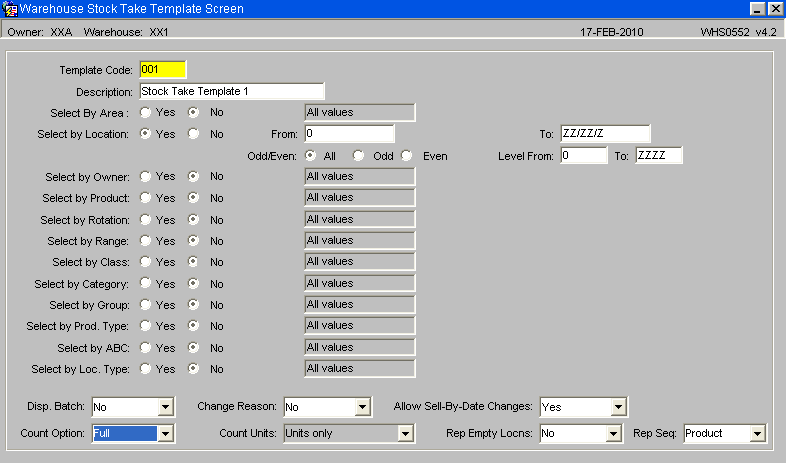
| Field Name | Description | Options |
|---|---|---|
| Template Code ** | Name of template – this name can be used for all future stock takes. A template name only needs to be created once and the details within that template can then be used for all future stock takes | 4 character free text field |
| Description | Description of template | 30 character free text field |
| Area | Allows selection by area – Y or N – N will default to ‘All’ | Must have been created in area codes maintenance – LOV available |
| Location | Allows selection by location code. If yes is selected then the option to choose location by Odd and Even as well as Range and Level is given | Must have been created in location codes maintenance – LOV available |
| Owner | Allows selection by Owner code – Y or N – N will default to ‘All’ | Must have been created in owner maintenance – LOV available |
| Product | Allows selection by Product code – Y or N – N will default to ‘All’ | Must have been created in stock maintenance – LOV available |
| Rotation | Allows selection by System Rotation – Y or N – N will default to ‘All’ | Must exist on the wms |
| Range | Allows selection by Product Range – Y or N – N will default to ‘All’ | Must have been set up in product class maintenance – LOV available |
| Class | Allows selection by Product Class – Y or N – N will default to ‘All’ | Must have been set up in product class maintenance – LOV available |
| Category | Allows selection by Product Category | Must have been set up in product class maintenance – LOV available |
| Group | Allows selection by Product Group | Must have been set up in product class maintenance – LOV available |
| Prod. Type | Allows selection by Product Type | Must have been set up in product type maintenance – LOV available |
| ABC | Allows selection by ABC code | The ABC flag must be set up in stock maintenance |
| Location Type | Allows selection by Location Type | Must have been created in location types maintenance – LOV available |
| Disp. Batch | Do you wish system rotation to be shown on the counting check sheet | Y or N – will default to N |
| Count Option | Full, Partial or Exception – The type of count will determine what information is required in the input screen. | Full = all information including batch and quantity
Partial = only quantities will be prompted for Exception = the system will default all values including the system quantities. If no changes are made, the count will accept the qty on the wms. |
| Count Units | Which UOM to count the stock in | Cases only
Units only Cases and Units (normal option) |
| Rep. Empty Locns | Do you wish the check sheet to report empty locations as well as those occupied | Y or N |
| Rep. Seq. | The sequence in which the check sheet will report the products to be counted | Location sequence or Product code sequence |
| Change Reason | If a qty is changed, do you wish a reason code to be entered (this will put the product on hold) | Y or N |
| Allow Sell by Date Changes. | Allows sell by dates to be changed | Y or N |
Stock Take Cycle Generation (WHS0541)
On entry to this screen the cursor will be in the Stock Take No field and the screen will be in enquiry mode. This allows previous generated stock take cycles to be viewed.
If the user stops the enquiry mode then a message “All movements must be completed before running stock take cycle generation” is given.
The user can then enter either a template code, which will bring up the stock take details of that code, or start a new definition using the same fields as the template program (details below)
See details of stock take template (WHS0552) for field information.
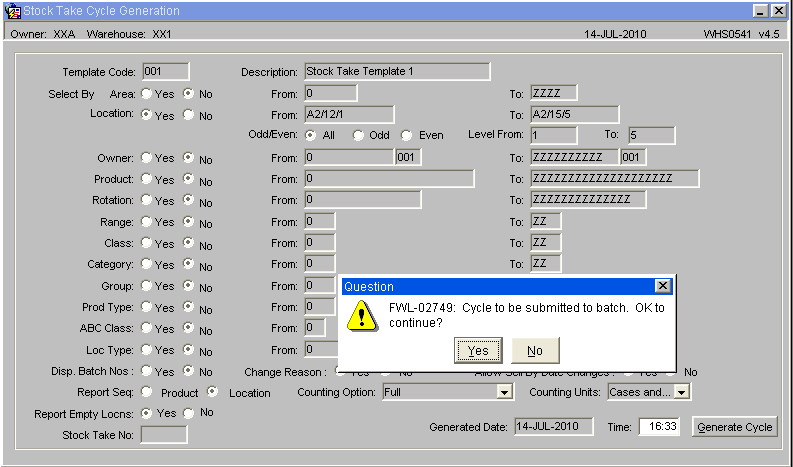
On entry of the stock take details and date/time the Generate Cycle button can be used to start the stock take. A message “Cycle to be submitted to batch. OK to continue?” is given and the user can select yes or no, if no is selected then nothing happens.
If yes is selected then a new stock take number will be automatically generated and displayed. The generate cycle procedure will take a precise snapshot record of the status of the selected stock in the warehouse, as known to the system at the specified date and time as entered on the screen.
Please note, all selected stock is ‘held’ when the snapshot is taken and only released after the completion of the stock take. This completion is done when either the stock take is confirmed, or rejected at Stock Take Update.
Stock Take Report (WHS0543)
This screen generates the stock take report print, for the manual count and input. If RF is being utilised then the stock take cycle will have been sent to the WCS ready to be accessed by an RF device.
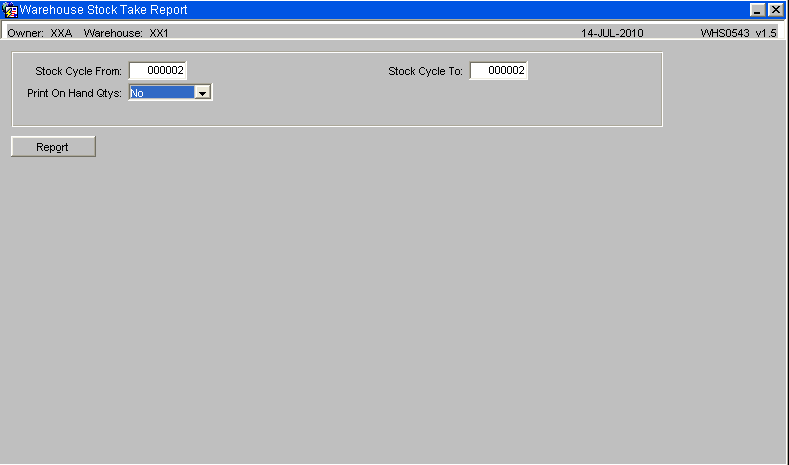
| Field Name | Description | Options |
|---|---|---|
| Stock Take Cycle From | Start Cycle for the report | Must be a valid stock take cycle – LOV available |
| Stock Take Cycle To | End Cycle for the report | Must be a valid stock take cycle – LOV available |
| Print On-Hand Quantities | Do you wish the system quantities to be printed on the report | Y or N |
| Buttons | ||
| Report | Generates the counting check sheet | |
The stock take sheets will print differently depending on which type of stock take is run, e.g. Full, Check, Partial or Exception. The type selected will be in the header of the report and the example below is of a 'Full' stock take.

If the cycle number is not present in the drop down list then the cycle has failed and the error report (WHS0541A) should be run instead.
Stock Take Error Report (WHS0541A)
If a Stock Take cycle fails (i.e. status ‘Cannot Complete’), this report provides the user with an explanation of why it happened. It can be used to correct those items that have caused the stock take to fail. Displayed details include allocated quantities, outstanding movements, system holds and overlapping stock take cycles. The stock take cycle will then have to be cancelled in the Stock Take Cleardown screen.

| Field Name | Description | Options |
|---|---|---|
| Stock Take Cycle No. | The stock take cycle number that is to be reported on | Must be a valid cycle – LOV available – note, the status of each cycle will be displayed |
| Buttons | ||
| Report | Generates the report | |

Stock Take Updates
The stock take updates comprise of inputting the stock details, updating these to the system and then clearing down the stock take.
Stock Take Count Input (WHS0544)
This screen allows the manually counted stock to be input against the locations of the stock take. If the stock take type is by Exception then the figures in the Cases/Units field will be automatically set to the system generated figures, these can then be changed as and when needed.
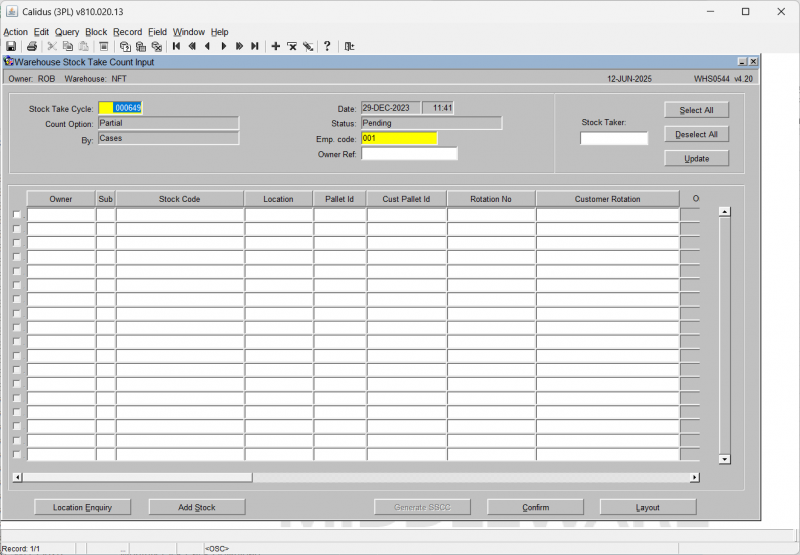
| Field Name | Description | Options |
|---|---|---|
| Stock Take Cycle ** | Allows the user to enter the cycle to be entered into the system | Must be a valid cycle – LOV available – note, the status of each cycle will be displayed |
| Date | Date and time of the stock take | Display Only |
| Count Option | Count option of the stock take | Display Only |
| Status | Status of the Stock take | Display Only |
| By | Count units of the stock take | Display Only |
| First Location | A start location to input from | Must be a valid location – leaving the field blank will default to ‘All’ |
| Emp Code | Enables the entry of an employee code | Must have been created in employee maintenance – LOV available |
| Owner Ref | ||
| Buttons | ||
| Location Enquiry | Allows the enquiry of a specific location | |
| Add Stock | Allows the addition of stock. This will take you to the Stock Take - New Data Input screen WHS0542. | |
| Confirm | Confirms the input details for the given stock take. | |
| Generate SSCC | Generate a new SSCC ID if required. | |
| Layout | Change the layout of the results table. You will be taken to WHS0909. | |
The screen will display all of the count information in a results table, where you can enter the actual counts.
The information in this table is configurable (through the Layout button) and the table can be scrolled horizontally to see more information if required.
New Data Input (WHS0542)
This screen allows the addition of new stock within a given location and for a given owner and stock code. In addition to the ‘normal’ data required for new stock a valid Reason Code and Employee Code must also be entered for auditing purposes.
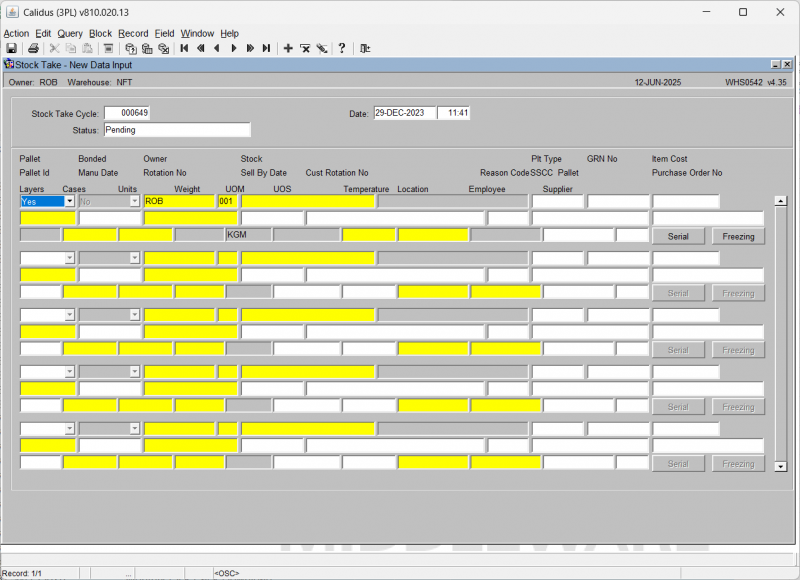
| Field Name | Description | Options |
|---|---|---|
| Stock Take Cycle ** | The stock take cycle number the stock is to be added to | Must be a valid cycle – LOV available – note, the status of each cycle will be displayed |
| Date ** | The date the stock has been added | Must be a valid date/time |
| Status | The status of the cycle | Display only |
| Pallet | Is the stock to be stored on a pallet | Y or N – default is Y |
| Bonded | Is the product bonded | Y or N – default is N |
| Location ** | The location code the stock is to be added into | Must have been created in location codes maintenance – LOV available |
| Owner ** | The owner code of the stock to be added | Will default to current |
| Stock ** | The stock code to be added | Must exist in stock code maintenance – LOV available |
| Type | The location type | Must exist in location types maintenance – LOV available |
| Pallet Id | Pallet Id of the line being added | If left blank the system will generate a pallet id |
| Manu Date | Manufacture date of the pallet | If required must be a valid date |
| Rotation No | System rotation number for the pallet | Only required if set against the stock code |
| Sell by Date | The sell by date of the product | Must be a valid date |
| Cust Rotation No | The customer rotation (batch) of the product | Only required if set against the owner and stock code |
| Reason Code | If required, the reason code of the entry – will put the stock on hold | Must exist in reason codes maintenance – LOV available |
| Layers | The no of layers entered (not migrated) | N/A |
| Cases | The quantity of cases to be added | 0 -99999 |
| Units | The quantity of units to be added | 0 – 99999 |
| Weight | The weight of the product to be added | 0 – 99999.99 |
| UOM | The unit of measure the product is held in | Dependant on the available stock UOM |
| UOS | The unit of sale of the product | i.e. weight, volume = set in stock UOM in stock maintenance |
| Buttons | ||
| Serial | Update serial numbers if applicable | |
| Freezing | Update Freeze information if applicable. | |
Stock Take Variance Report (WHS0546)
This is also called the ‘Discrepancy report’ and will show the details of all locations for a specific stock take cycle. In particular it will show ‘on hand’ quantities (as recorded by the ‘snapshot’ taken in the ‘Stock Take Cycle Generation’ Procedure), the stock take quantities, quantity variances, the checker’s ID and date/time that the location was checked. Grand totals by owner and for each stock code are also printed.
![]() Note: The On-Hand, Entered and Variance quantities will not be shown if the Counting units option for the stock take is set to Units only.
Note: The On-Hand, Entered and Variance quantities will not be shown if the Counting units option for the stock take is set to Units only.

| Field Name | Description | Options |
|---|---|---|
| Stock Cycle From No. ** | The starting stock take cycle number to report from | Must be a valid cycle – LOV available – note, the status of each cycle will be displayed |
| Stock Cycle To No. ** | The end stock take cycle number to report from | Must be a valid cycle – LOV available – note, the status of each cycle will be displayed |
| Print Detail, Summary or Both | Enables the printing of a detail report or just summary | Detail, Summary, Both |
| Select Owner | Allows printing to be by specific owner (takes current) | Y or N |
| Buttons | ||
| Report | Generates the report | |
Examples of Variance Reports


Stock Take Update (WHS0545)
Each stock take cycle can be rechecked until the stock take supervisor is satisfied that the stock take is correct. At this time, the update screen can be used to accept or reject the stock take and revise the system details accordingly.
If a stock take count number is entered, only those discrepancies accepted by that stock count number would then be updated. This then allows a phased update of remaining discrepancies over several re-counts. Those pallets that are accepted are released for further processing within the warehouse operation.
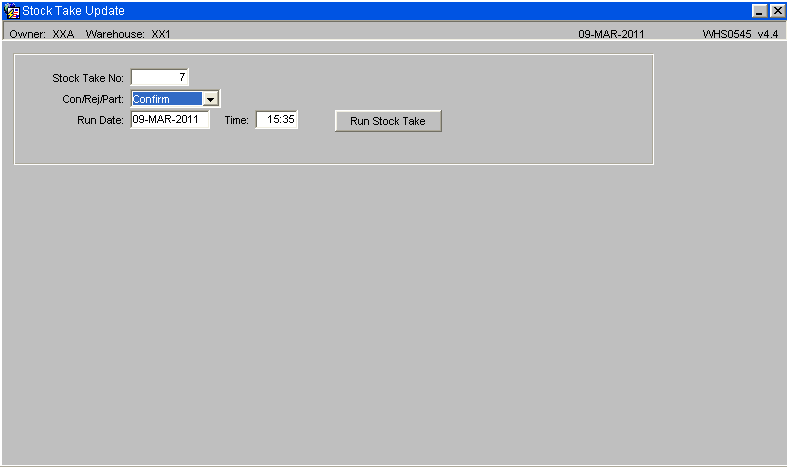
| Field Name | Description | Options |
|---|---|---|
| Stock Take No. | Stock Take Number | Must be a valid cycle – LOV available – note, the status of each cycle will be displayed |
| Con/Rej/Part | Type of Stock Take update | ‘Con’ - This is used for a full and final confirmation of all stock take amendments made on this cycle number. When ‘Run Stock Take’ is pressed the updates are committed and audit records of type STTK are created to reflect the quantities , plus or minus, of each pallet of each stock item that has been altered or added This will always produce a Stock take variance report
‘Rej’ - This is used to totally reject the selected stock take cycle; no change will be made to the stock amounts. No audits records produced ‘Part’ - This removes the temporary stock take records that have both old and new values that are equal. It leaves just the records that have been altered / added to be processed. If further stock checks are required, return to the Stock Take Count Input screen for further adjustments. *** The user must eventually either Confirm or Reject the stock take cycle. Confirm is the only option that finally updates/adds location records and audit records |
| Run Date | Date that the update is run | Must be a valid date |
| Time | Time that the update is run | Must be a valid time HH:MM |
| Buttons | ||
| Run Stock Take | Runs the Stock Take Update | |
Stock Take Cleardown (WHS0547)
The stock take Cleardown is completed after the stock take cycle has been updated.
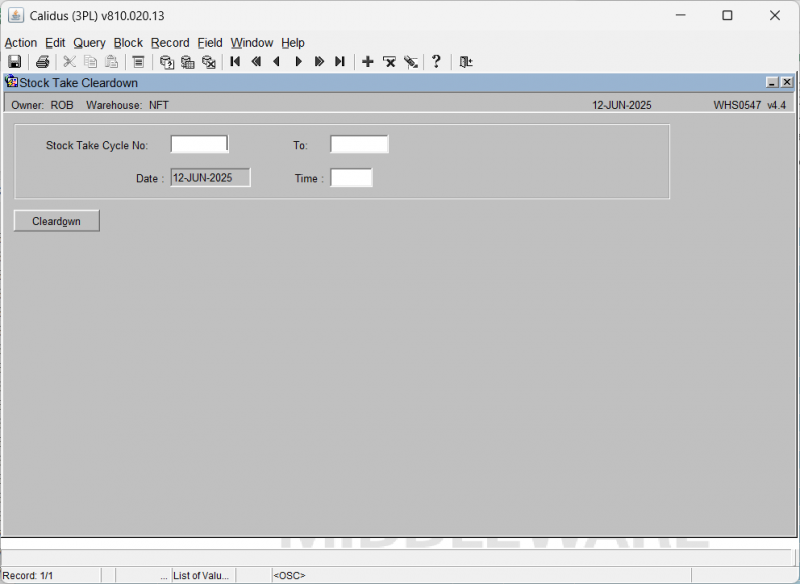
| Field Name | Description | Options |
|---|---|---|
| Stock Take Cycle No/To | The range of stock take cycle numbers to be cleared down | Must be a valid cycle – LOV available – note, the status of each cycle will be displayed |
| Run Date | Date that the update is run. | Must be a valid date – will default to today |
| Time | Time that the update is run. | Must be a valid time HH:MM |
| Buttons | ||
| Cleardown | Initiates the stock take Cleardown. | |
![]() Note: The Cleardown can be done on a range of Stock Take Cycles. Entry of the number of the highest cycle that is not at status pending, and all cycles at status rejected, confirmed and cannot complete will be deleted. Any cycles at status pending will be unaffected by the Cleardown.
Note: The Cleardown can be done on a range of Stock Take Cycles. Entry of the number of the highest cycle that is not at status pending, and all cycles at status rejected, confirmed and cannot complete will be deleted. Any cycles at status pending will be unaffected by the Cleardown.
Appendix A: Document History
A.1 References
| Ref No | Document Title & ID | Version | Date |
|---|---|---|---|
| 1 | |||
| 2 | |||
| 3 |
A.2 Glossary
| Term or Acronym | Meaning |
|---|---|
| Ad Hoc (WCS) | A task instigated on the device (spec. Ad Hoc Pallet Move), rather than a task instigated from the WMS and Stock Control. |
| Advice Note Number | An external reference linked to a Goods Receipt. |
| Aisle (WMS) | A component of a location; usually a space through rows of racking or storage locations; a collection of locations; |
| Allocation (order) | The systemic act of identifying and ring-fencing product matching the order requirements, following proscribed warehouse rules. |
| Anchor Point (WMS) | A starting location for a search for a suitable storage location; auto-putaway location suggestion start point. |
| Area (WMS) | A collection of aisles; an area in the warehouse for a particular purpose. |
| Batch (WMS) | A production batch of a product; a quantity of product that is considered to have the same characteristics; |
| Bay (Warehouse) | A physical loading or unloading point for the warehouse. |
| Bay (WMS) | A component of a location; usually a space between uprights in racking, comprising several levels (horizontal beams). |
| Bay Diary | The mechanism for booking hauliers inbound/outbound and assigning bays. The OBS Logistics system is CALIDUS Bay Diary. |
| Block Stack | A stable stack of pallets. |
| Booking | A time slot for a bay, booked with a Carrier/Haulier. |
| Bulk (WMS) | Bulk storage; Usually full-pallet storage areas, racked or stacked. |
| Cancellation (WCS) | The facility to cancel a task due to some problem, identified by the user when performing the task. |
| Carrier; Haulier | The transport company (by road or sea). |
| Check Digit (WMS) | A short code, usually randomly generated and stored against a location, used to help identify that a user is at the right location before they proceed with a warehouse task. |
| Container | The actual physical container, identified uniquely by the Container Number. The Container will be identified as a Container Type. |
| Container Type | Descriptive of the use and capability and physical characteristics of a container. Container types are 40ft End Loader, Reefer, etc. |
| Container Yard | The storage areas for full and empty locations in the facility. The OBS Logistics system to manage this area is CALIDUS Container Yard. |
| CSV | Character-separated values; a text file with multiple rows and values, usually separated with commas. |
| C-WCS | CALIDUS WCS, the name of the OBS Logistics Warehouse Control system |
| C-WMS | CALIDUS WMS, the name of the OBS Logistics Warehouse Management system |
| Dead Leg (WCS) | A movement of a truck without a pallet; wasted resource. |
| Despatch | The final physical stage of an order; handover of goods to the haulier. |
| De-stuffing | The act of emptying a container and storing the contents in the warehouse. |
| Drive-In | A drive-in location, typically multi-level, multi-deep location. |
| Dry Van | Any type of non-refrigerated container. |
| Dual Cycling | Processes utilizing P&D locations for interleaving tasks in and out of specific areas, reducing dead leg movements. |
| EDI | Electronic Data Interchange; any form of automatically or semi-automatically uploading or downloading information from a computer system without manually re-keying the information. |
| ERP | Enterprise Resource Planning; a system for this. |
| Exchange (WCS) | Specifically Pick Exchange or Task Exchange. The process of allowing a user to select a different pallet in a multi-pallet location and exchanging the expected pallet for this one. If the pallet is planned for another task, task exchange will complete this task instead of the expected one first. If the pallet is not planned, pallet exchange will swap the pallet (if suitable). |
| GR; GRN | Goods Receipt; Goods Receipt Number or Note |
| High Bay | Typically tall (greater than 5 level) racking, usually full pallet storage, usually Narrow Aisle. |
| Inbound (Booking) | A booking linked to a Goods Receipt. |
| JIT | Just In Time; processes designed to trigger at the last instant. |
| KPI | Key Performance Indicator. |
| Level (WMS) | A component of a location; usually the vertical compartments of an area, delineated by horizontal beams. |
| Loading | The act of loading pallets onto a vehicle. |
| Location (WMS) | A uniquely identified space in the warehouse for storage of product. There are many types, most commonly Floor locations (for example, Marshalling, Inbound), Racking or Bulk Storage Locations and Pick faces. |
| Manifest | The contents of a vehicle or container. |
| Marshalling | The act of bringing pallets for an order or load together; an area to do so. |
| Multi-deep | A location with 2 or more pallets stored sequentially i.e. only one can be accessed at a time. |
| NA (WCS) | Narrow Aisle; usually any area in the warehouse that is restricted access due to space limitations, Narrow Aisles have associate P&D locations. |
| Outbound (Booking) | A booking linked to a Sales Order. |
| P&D | Pick-up and Drop-off locations; locations used to control the handover of pallets between distinct areas, for example between chambers and the wider area of the warehouse. |
| PI; Perpetual Inventory | The act of continuously checking locations in a warehouse, identifying and correcting product quantity issues. Usually used in Bulk environments rather than Pick Faces. In pick faces, this process is called is called Residual Stock Balance and usually takes place after picking from a pick face. |
| Pick Face | A location designed for picking part of a pallet of stock. Usually a low- or ground-level location. |
| Pick List (order) | The instructions to pick pallets or cases from locations; the paper report associated to this; the stage of preparing these instructions; the sending of these instructions to WCS. |
| PO | Purchase Order. |
| Pre-advice; Goods Receipt Pre-advice | An advanced notification of what is being received. Part of a manifest. Pre-advices can be stock and quantity, or individual pallet level. |
| Putaway | The physical move of a pallet to a storage location as a result of receiving it into the warehouse. |
| RAG | Acronym for Red/Amber/Green, a traffic light colouration system depicting (in sequence) Errors, Warnings or Informational messages. Usually used in operational monitoring to effectively display when certain processes are not working as expected. |
| RDT | Radio Data Terminal. |
| Reefers | Refrigerated Containers. |
| Replen; Replenishment | The act of moving product (usually a pallet) from bulk storage to a pick face. |
| Reposition (WCS) | The facility to change the location of a movement or putaway when at the final destination, sue to some issue discovered when performing the task. |
| RF | Radio Frequency; An RF device is an RDT, typically used by CALIDUS WCS for executing warehouse tasks. |
| SCR; CR | Software Change Request. |
| Short Allocate | The process of not fulfilling an order due to failure to identify sufficient product at Allocation. |
| Short Pick | The process of not fulfilling an order due to failure to identify sufficient product when picking. May also be used as a term to indicate Short Allocation. |
| SO | Sales Order. |
| Truck Types | Plants, Mechanical Handling Equipment. For example, Reach trucks, Counter-balance trucks, pallet riders, etc. |
| UOM | Unit of Measure. |
| WA (WCS) | Wide Area; usually any area in the warehouse that is not restricted access due to space limitations, for example, floor areas, not Narrow Aisle. |
| WCS | Warehouse Control System |
| WMS | Warehouse Management System |
Oracle App Terms
| Term or Acronym | Description |
|---|---|
| DDL | Drop-down list of values, usually denoted by a down-arrow to the right of the field. |
| LOV; Lookup | List of Values. A Lookup of values from data maintained in the system (rather than fixed data that a DDL may be used for), |
| Form; Window; Screen | Alternative terms for each displayed window within the application. |
| Tab | A tab on a form, which contains its own panel of data to be viewed or entered. Denoted in this guide as italics. |
| Panel | A panel on a form contains data to be viewed or entered. |
| Button | A clickable button. Denoted in this guide as bold. |
| Field | Data that can be displayed or entered is referred to as a field. This is the core of where you will view or enter information within Forms. Fields are described by Labels and usually come as a pair. These (and labels) are denoted in this guide as italics. |
| Table | When there are multiple data to be shown in a group, those records are usually displayed in a table. Tables allow showing multiple fields in columns, are scrollable vertically and sometimes horizontally, will have buttons for title labels if the columns are sortable and may allow configuration, usually through a Configure button, which will take you to WHS0909. |
| Label | A label is the annotation of the field being displayed and typically tells you what it is. CWMS supports multi-lingual labels in a lot of forms. |
| Click; Select | Clicking the left mouse mutton on a field, table or button using your mouse. |
| Right-click | Clicking the right mouse mutton on a field, table or button using your mouse. |
| Viewport | The viewport is the means by which you are viewing the forms within the application. Within a browser, this may be the size of the browser window, or just a fixed portion. When running the app browserless, this is the size of the window displayed on your desktop. |
| DPI | Dots per Inch. This may be used to adjust the resolution of the application within the viewport. |
| Menu | The menu where all forms are selected, as opposed to the Oracle standard query menu. In CWMS, this is the Explorer window. (FXMEXPLR). Menu items are sometimes denoted in this guide in bold/italics. Slashes typically indicate a sub-menu. for example, Warehousing/Goods Receipt/Goods Received Advice denotes the top-level Warehousing menu, then the Goods Receipt sub-menu, and then the Goods Received Advice screen. As menus in CWMS are pretty much completely user configurable, this may have less meaning than you would like in your system, and we generally refer to these on what we call the standard menu structure. |
| Control Bar; Format bar | The control bar for searching, inserting and pretty much doing anything within the selected Oracle form. See System_Navigation_Guide#Format_Toolbar for more information. |
| Key; Function Key; Shortcut Key | Alternative terms for a keypress on your keyboard. In this guide, these are denoted with fixed width text in a box e.g. F4
|
| Multi-Modal | A term denoting whether the forms can be open and active at the same time. CWMS is not multi-modal. |
| Scroll | The act of moving a fixed window vertically or horizontally to show more information. Typically you will see and use these on tables. |
| Check box | A simple notation of whether something is enabled or disabled (or Yes or No, True or False, etc) is typically displayed as a checkbox. If the box is checked, then this means Yes/True/Enabled, the functionality depending on the label of the checkbox. |
| Option Select; Radio Buttons | When a field has a limited number of options, sometimes this is displayed with bulleted options, all visible n the screen. This is called an Option Select or Radio button. The option that is selected will have the button filled in. |
A.3 Document History
| Version | Date | Status | Reason | By |
|---|---|---|---|---|
| 1.0 | 08/03/2011 | Issue | Initial Version | LBW |
| 2.0 | 30/04/2025 | Issue | Updated version for formatting | ANW |
| 2.1 | 30/06/2025 | Draft | Minor formatting corrections | ANW |
A.4 Authorised By
Matt Tipping | Aptean Project Manager | _____________________________ |
Tony Walker | Aptean Consultant | _____________________________ |